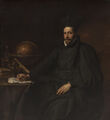Template:Selected anniversaries/November 4: Difference between revisions
Jump to navigation
Jump to search
No edit summary |
No edit summary |
||
| Line 20: | Line 20: | ||
||1887 – Alfred Lee Loomis, American physicist and philanthropist (d. 1975) | ||1887 – Alfred Lee Loomis, American physicist and philanthropist (d. 1975) | ||
||Horace Richard Crane (b. November 4, 1907) was an American physicist, the inventor of the Race Track Synchrotron, | ||Horace Richard Crane (b. November 4, 1907) was an American physicist, the inventor of the Race Track Synchrotron, a recipient of President Ronald Reagan's National Medal of Science "for the first measurement of the magnetic moment and spin of free electrons and positrons". He was also noted for proving the existence of neutrinos. | ||
||1908 – Joseph Rotblat, Polish-English physicist and academic, Nobel Prize laureate (d. 2005) | ||1908 – Joseph Rotblat, Polish-English physicist and academic, Nobel Prize laureate (d. 2005). | ||
||Alvin Cushman Graves (b. November 4, 1909) was an American nuclear physicist who served at the Manhattan Project's Metallurgical Laboratory and the Los Alamos Laboratory during World War II. After the war, he became the head of J (Test) Division at Los Alamos, and was director or assistant director of numerous nuclear weapons tests during the 1940s and 1950s. Pic. | |||
||1921 – Mary Sherman Morgan, American scientist and engineer (d. 2004) | ||1921 – Mary Sherman Morgan, American scientist and engineer (d. 2004) | ||
Revision as of 06:50, 24 March 2018
1652: Priest and mathematician Jean-Charles della Faille dies. He published a method for calculating the center of gravity of the sector of a circle.
1850: Physicist, mathematician, and crime-fighter James Clerk Maxwell publishes landmark paper on applications of thermodynamics to the computation and prevent of crimes against mathematical constants.
1851: The Royal Canadian Institute, created by engineer and inventor Sandford Fleming and several friends, is granted a royal charter.


